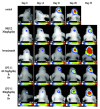The potential of polymeric micelles in the context of glioblastoma therapy
- PMID: 24416018
- PMCID: PMC3874582
- DOI: 10.3389/fphar.2013.00157
The potential of polymeric micelles in the context of glioblastoma therapy
Abstract
Glioblastoma multiforme (GBM), a type of malignant glioma, is the most common form of brain cancer found in adults. The current standard of care for GBM involves adjuvant temozolomide-based chemotherapy in conjunction with radiotherapy, yet patients still suffer from poor outcomes with a median survival of 14.6 months. Many novel therapeutic agents that are toxic to GBM cells in vitro cannot sufficiently accumulate at the site of an intracranial tumor after systemic administration. Thus, new delivery strategies must be developed to allow for adequate intratumoral accumulation of such therapeutic agents. Polymeric micelles offer the potential to improve delivery to brain tumors as they have demonstrated the capacity to be effective carriers of chemotherapy drugs, genes, and proteins in various preclinical GBM studies. In addition to this, targeting moieties and trigger-dependent release mechanisms incorporated into the design of these particles can promote more specific delivery of a therapeutic agent to a tumor site. However, despite these advantages, there are currently no micelle formulations targeting brain cancer in clinical trials. Here, we highlight key aspects of the design of polymeric micelles as therapeutic delivery systems with a review of their clinical applications in several non-brain tumor cancer types. We also discuss their potential to serve as nanocarriers targeting GBM, the major barriers preventing their clinical implementation in this disease context, as well as current approaches to overcome these limitations.
Keywords: controlled release; drug delivery; glioblastoma; micelles; nanoparticle; targeted delivery.
Figures



Similar articles
-
cRGD peptide-installed epirubicin-loaded polymeric micelles for effective targeted therapy against brain tumors.J Control Release. 2017 Jul 28;258:56-66. doi: 10.1016/j.jconrel.2017.04.033. Epub 2017 May 5. J Control Release. 2017. PMID: 28483513
-
Macromolecular Drug Carriers for Targeted Glioblastoma Therapy: Preclinical Studies, Challenges, and Future Perspectives.Front Oncol. 2018 Dec 17;8:624. doi: 10.3389/fonc.2018.00624. eCollection 2018. Front Oncol. 2018. PMID: 30619758 Free PMC article. Review.
-
Advanced targeted therapies in cancer: Drug nanocarriers, the future of chemotherapy.Eur J Pharm Biopharm. 2015 Jun;93:52-79. doi: 10.1016/j.ejpb.2015.03.018. Epub 2015 Mar 23. Eur J Pharm Biopharm. 2015. PMID: 25813885 Review.
-
A stapled peptide antagonist of MDM2 carried by polymeric micelles sensitizes glioblastoma to temozolomide treatment through p53 activation.J Control Release. 2015 Nov 28;218:29-35. doi: 10.1016/j.jconrel.2015.09.061. Epub 2015 Sep 30. J Control Release. 2015. PMID: 26428461 Free PMC article.
-
Nanomedicine associated with photodynamic therapy for glioblastoma treatment.Biophys Rev. 2017 Oct;9(5):761-773. doi: 10.1007/s12551-017-0293-3. Epub 2017 Aug 19. Biophys Rev. 2017. PMID: 28823025 Free PMC article. Review.
Cited by
-
Polymeric Micelles in Colorectal Cancer Therapy: A Comprehensive Review of Nano-drug Delivery Strategies, Copolymer Types, Physicochemical Characteristics, and Therapeutic Applications.Curr Med Chem. 2025;32(20):4033-4054. doi: 10.2174/0109298673306752240726104241. Curr Med Chem. 2025. PMID: 39092735 Review.
-
Redox-Sensitive Camptothecin Prodrug: A Promising Drug Delivery Strategy with Ultrahigh Drug Loading and Tunable Drug Release.Nano TransMed. 2025 May 11;4:100088. doi: 10.1016/j.ntm.2025.100088. Online ahead of print. Nano TransMed. 2025. PMID: 40821452 Free PMC article.
-
PAMAM Dendrimer Nanomolecules Utilized as Drug Delivery Systems for Potential Treatment of Glioblastoma: A Systematic Review.Int J Nanomedicine. 2020 Apr 23;15:2789-2808. doi: 10.2147/IJN.S243155. eCollection 2020. Int J Nanomedicine. 2020. PMID: 32368055 Free PMC article.
-
Delivery of a drug cache to glioma cells overexpressing platelet-derived growth factor receptor using lipid nanocarriers.Nanomedicine (Lond). 2016 Mar;11(6):581-95. doi: 10.2217/nnm.15.218. Epub 2016 Mar 22. Nanomedicine (Lond). 2016. PMID: 27003178 Free PMC article.
-
Polymeric nanocarriers for therapeutic gene delivery.Asian J Pharm Sci. 2025 Feb;20(1):101015. doi: 10.1016/j.ajps.2025.101015. Epub 2025 Jan 4. Asian J Pharm Sci. 2025. PMID: 39931356 Free PMC article. Review.
References
-
- Alami N., Banerjee K., Juste S., Page V., Brossard M., Hayashi T., et al. (2006). NC-6004, a novel cisplatin-incorporated polymeric micelle, is highly effective against oxaliplatin-resistant tumor models. AACR Meet. Abstr. 2006 133
Publication types
Grants and funding
LinkOut - more resources
Full Text Sources
Other Literature Sources

